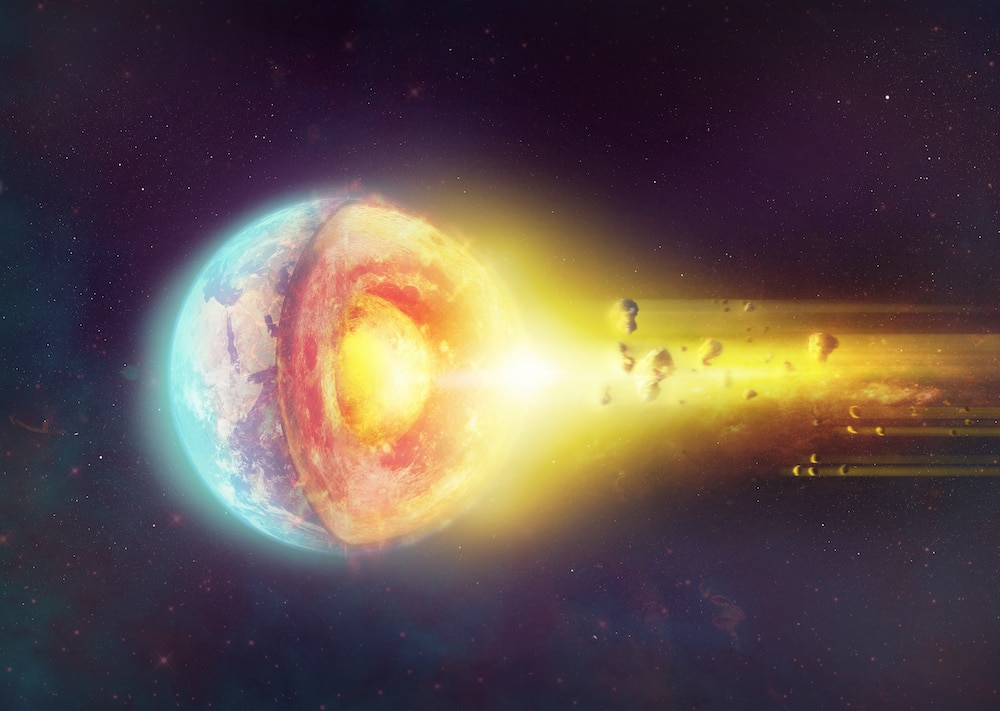Create a free profile to get unlimited access to exclusive videos, sweepstakes, and more!
Under pressure, iron takes on super strength in Earth’s core
When you put iron under intense heat and pressure, it morphs into something stronger than any superhero.

From space, Earth may not look like it’s Hulking out, but what all those astronaut Instagram photos can’t capture is its hidden superpower.
This is already sounding like another Avengers movie in the making. When you put iron under intense pressure (360 million times more than on the surface), it morphs into a substance with the unfathomable strength of the Hulk and the toughness of Thor’s hammer. But wait. How can anyone even prove this when there is no way to see through miles of crust and mantle to the outer core? With more things that could pass for special effects, of course. Think lasers.
Nobody has ever seen what researchers at SLAC (Stanford Linear Accelerator Center) managed to accomplish. Led by Sébastien Merkel of the Université de Lille, they recently published a study in Physical Review Letters after hitting iron with enough laser power to replicate conditions in the outer core. Shock compression and extreme heat caused the atoms to dislocate and rearrange themselves as if otherworldly forces were in control.
“For a very short time, you need very high stresses to deform iron,” Merkel told SYFY WIRE. “After a few nanoseconds, the stress required to deform iron decreases; our measurements were performed with a pressure that is 1.9 million times that of Earth’s atmosphere.”
Undisturbed iron atoms are arranged in cubes. The optical laser used in the experiment sent a shock wave though them and dislocated everything. Under extreme pressure and heat, the atoms experience more stress than they know what to do with, so their cube structures will transform into hexagonal prisms to relieve that stress in the most efficient way possible. These prisms then rotate sideways, attaching to each other at symmetrical facets in a phenomenon known as twinning. This gives the iron incredible — though temporary — super strength.
When certain metals experience punishing conditions within a short amount of time, they undergo twinning because the defects caused by those conditions need to get moving within the metal. If they had more time, the diffusion process would kick in, and atoms would move into gaps caused by heat. The crystal structure that their atoms arrange themselves in when they need to act fast is restrictive. However, the crystals offer almost instant stress relief for rapid deformations by relaxing stress in the direction that stress is being forced on them.
What might be even more amazing than that is that Merkel and his team were able to observe this phenomenon with another laser, SLAC’s Linac Coherent Light Source (LCLS). LCLS is an X-ray free-electron laser that allowed them to observe the iron on an atomic level as it morphed, and to measure it in a billionth of a second. It was like capturing a nanosecond and freezing it.
“The LCLS allows very very fast measurements of X-ray diffraction,” Merkel said. "With a laboratory X-ray machine, you would expect measurements on the order of hours. Even synchrotrons take between 0.2 and 2 seconds. With X-Ray diffraction, we can map atom positions in space. “
LCLS is an ultrafast laser that makes any other method seem ridiculously slow in comparison. Its X-ray diffraction capabilities take only 50 femtoseconds (quadrillionths of a second) to measure what is going on, enough to blow even the researchers’ minds. It does this by zapping the target with pulses of light with only femtoseconds between them. The sample of iron, which had a polymer glued to its back, had optical laser pulses sent through the polymer. These pulses, between 5 and 20 nanoseconds, vaporized the polymer to set off a shock wave.
While twinning had been suspected to happen in the Earth’s outer core, creating outer core conditions in a lab has given this idea more support. The only difference is that deformation is thought to happen much more slowly deep inside the planet. This is why there are some scientists out there who still believe that iron facing those conditions retains its cubic arrangement of atoms instead of twinning, but when running the experiment, all Merkel saw was a hexagonal arrangement. The upcoming MEC-U laser will shed more light on this.
“With future lasers, we will be able to send multiple pulses, shortly after each other,” said Merkel. “The first pulse gives a large kick in pressure in temperature, then we use additional pulses to increase pressure and keeping temperature under control.”
LCLS is powerful, but can heat up iron too much, melting it if the experiment isn’t fast enough. Having access to a nex-gen laser will not only help gauge the conditions of Earth’s outer core more accurately, but possibly those of its inner core, and even in the cores of other planets. Iron asteroids like Psyche are thought to have once been the molten cores of protoplanets that were eviscerated in the chaotic early solar system. More might be revealed about the innards of Jupiter and Saturn. Predictions could also be made about exoplanets, especially super-Earths.
“Super-Earths are interesting,” Merkel said. “Objects collide around their stars, heat up, melt, and then form a planet. MEC-U should give us more insight into this process.”


























